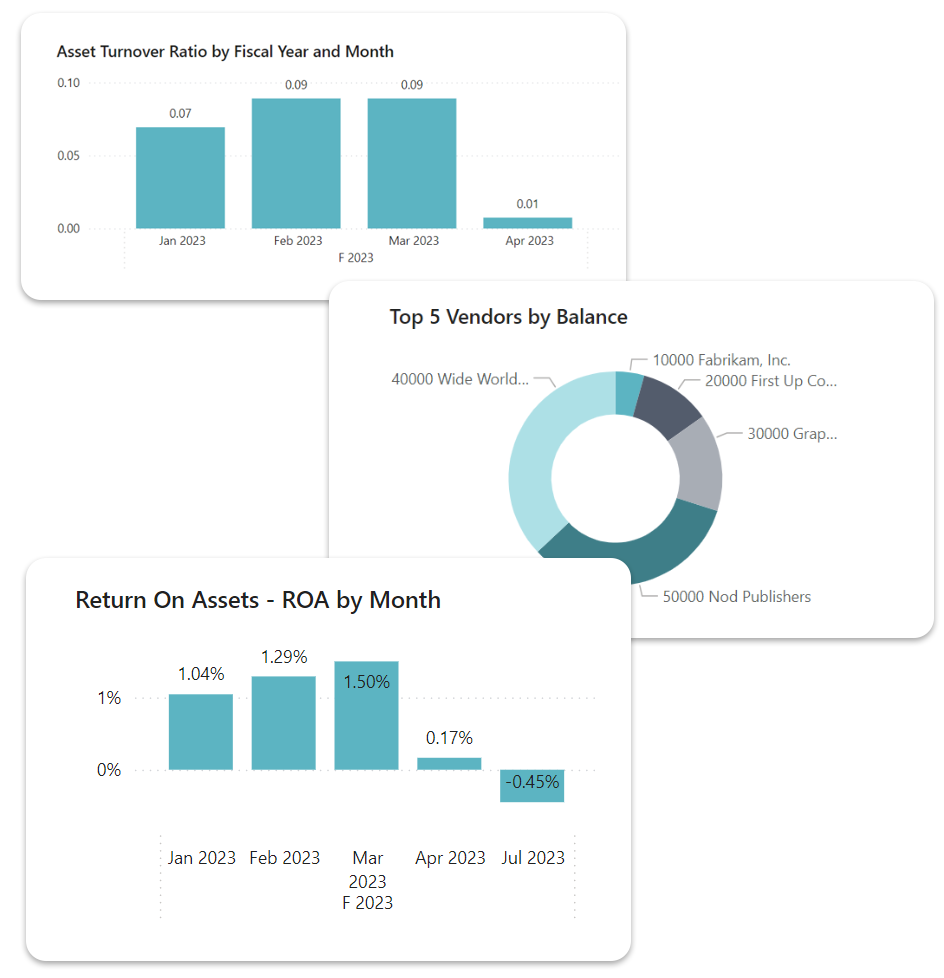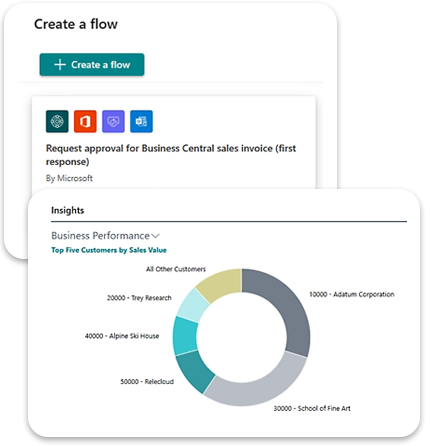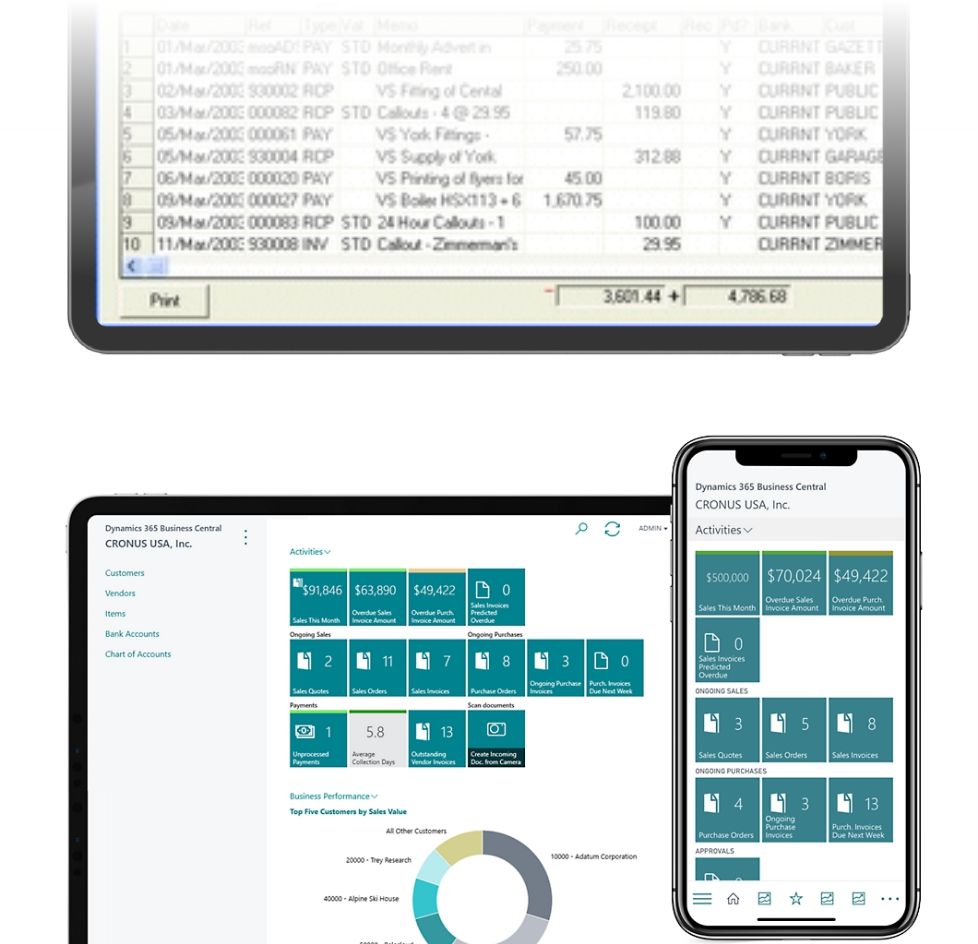MICROSOFT DYNAMICS 365 BUSINESS CENTRAL
Increase Financial Efficiency With Microsoft Dynamics for SMEs.
Microsoft Dynamics 365 Business Central has helped thousands of SMEs transition from creaking-finance systems to a modern, efficient and streamlined ERP system that helps to drive growth.

.png?width=540&height=468&name=Dynamics-Hero-Idea%204v4%20%20RESIZED%20(540%20x%20468%20px).png)




MICROSOFT DYNAMICS 365 BC FUNCTIONALITY
Everything you need to run an efficient finance team - and much, much more.
Microsoft Dynamics 365 Business Central is more than just an ERP system—it’s a unified platform designed to connect every part of your business, enabling smarter decisions and sustainable growth.
Whether you're struggling with disjointed systems, manual workarounds, or limited financial visibility, Business Central brings everything together under one intuitive cloud solution. See all features below.
Core Functionality
Microsoft Dynamics 365 Business Central provides a comprehensive suite that seamlessly integrates your business processes—from finance and operations to sales and service. This all-in-one ERP platform empowers your teams with the insights and efficiency they need to operate effective
Unified Data Platform: Combines all your critical business functions into a single system, ensuring consistent and up-to-date information across departments.
Automation and Workflows: Automates routine processes like approvals, invoicing, and order processing, reducing manual tasks and errors.
Cloud-Based Accessibility: Operate from anywhere with secure cloud access, allowing teams to collaborate in real time.

Purchase Ledger
Microsoft Dynamics 365 Business Central makes managing your supplier payments effortless by automating time-consuming manual tasks and centralising all purchase data in one place.
It helps you stay in control of cash flow, monitor spend, and maintain strong supplier relationships.
Streamlined Supplier Management: Manage suppliers, track purchase orders, and record invoices in one system for better oversight and faster approvals.
Automated Matching: Automatically match purchase orders, receipts, and invoices to reduce errors and prevent overpayments.
Insightful Spend Analysis: Access real-time data on supplier performance and costs to make more informed purchasing decisions.

Sales Ledger
Microsoft Dynamics 365 Business Central brings clarity and control to your accounts receivable processes by consolidating customer data and automating invoicing.
This ensures accurate records, timely payments and better management of customer accounts.
Customer Account Visibility: Instantly view full customer histories, outstanding balances, and credit limits.
Automated Invoicing & Reminders: Accelerate billing and improve cash collection with recurring invoices and overdue payment reminders.
Integrated CRM Functions: Connect sales and finance by linking transactions to customer relationship activities and pipelines.

Cash Management
Stay in control of your company’s financial position with real-time cash visibility, automated bank reconciliations, and accurate forecasting tools.
Business Central supports confident financial planning and helps avoid unpleasant surprises.
Bank Integration: Reconcile bank statements effortlessly with automatic feeds and smart reconciliation tools.
Cash Flow Forecasting: Predict future cash requirements with dynamic forecasts based on actual and projected transactions.
Multi-Currency Capabilities: Handle international payments and receipts seamlessly with built-in currency conversion and tracking.

Operations
Microsoft Dynamics 365 Business Central connects procurement, stock and fulfilment workflows into a single streamlined system.
This ensures greater control, fewer delays, and increased efficiency across your operations.
Stock & Warehouse Management: Monitor stock levels, locations, and movement in real-time to reduce waste and avoid shortages.
Supply Chain Visibility: Take control of purchasing, production, and delivery with integrated operational workflows.
Production & Job Costing: Track manufacturing and project costs precisely, including time, resources, and outputs.

Reporting
Give your decision-makers instant access to accurate, real-time data across the business.
Business Central’s robust reporting tools help you monitor key performance indicators, spot trends, and make strategic decisions with confidence.
Customisable Dashboards: Create role-specific dashboards that highlight the most relevant business metrics.
Real-Time Reporting: Access live reports across departments without delays from manual updates or batch processing.
Power BI Integration: Enhance your reporting with seamless integration to Power BI for advanced visualisation and analytics.

Want to know more? Download the Microsoft Dynamics 365 Business Central Brochure
Find out more about Microsoft Dynamics 365 Business Central and how it can connect every team in your business by downloading the brochure in PDF format.


Accounts Software vs ERP Software
Your Old Accounts Software Is Holding You Back. It's Time for ERP.
While traditional accounting software handles your finances, it often fails to support wider business operations or scale with growth.
ERP software, on the other hand, integrates finance with departments like operations, sales, and inventory—transforming how your entire business runs.
Your Current
Accounts Software
8 /month
Microsoft Dynamics 365
Business Central
8 /month
Your Current
Accounts Software
Microsoft Dynamics 365
Business Central
Financial Management
Operational Integration
Scalability & Flexibility
Data & Decision Making
Dynamics Business Central by Job Role
Your Job, But Easier.

Finance Directors
Gain real-time access to your company’s financial performance — empowering finance directors to make data-driven decisions.
Book A Demo To See How >

Managing Directors
Get a 360° view of your entire business — empowering managing directors to oversee all departments in one centralised system.
Book A Demo To See How >

Operations Directors
Streamline workflows across your entire supply chain — giving operations directors full visibility & real time performance updates.
Book A Demo To See How >

Financial Controllers
Automate reconciliations and compliance tasks — enabling financial controllers to close the books faster & ensure accuracy.
Book A Demo To See How >

Stock Controllers
Real-time stock levels, reordering alerts, and full traceability mean you’re always one step ahead of shortages or overstocking.
Book A Demo To See How >

Purchasing Managers
Empower purchasing managers to plan smarter with data-driven purchase orders that balance sales demand, lead times and stock levels.
Book A Demo To See How >
Microsoft Dynamics 365 Business Pricing
How Much With Your New ERP System Cost?
See Our Example System Prices Below...
While every ERP implementation is tailored to your business, the examples below give you a clear idea of what to expect—no surprises, no hidden costs, just transparent pricing that scales with your needs. All pricing examples are based on a three year term and include licences, implementation and support.
Basic
£1,200 Per Month.
Approx. Pricing. 3 Year Term.
- Includes 7 users (4x full users, 3x light)
- Includes set up and configuration of financials, reporting and project management
- Includes go-live and on-going support
Standard
Most Popular£2,200 Per Month.
Approx. Pricing. 3 Year Term.
- Includes 15 users (10x full users, 5x light)
- Includes set up and configuration of financials, reporting, project management and multi-location inventory
- Includes go-live and on-going support
Advanced
£2,800 Per Month.
Approx. Pricing. 3 Year Term
- Includes 13 users (8x premium users, 5x light)
- Includes set up and configuration of financials, reporting, supply chain management, stock and manufacturing
- Includes go-live and ongoing support
ABOUT US
See why businesses choose The HBP Group



Unbeatable Product Knowledge & Experience
With over 30 years of experience implementing ERP and accounting systems across a wide range of industries, we’ve seen it all.
Our deep understanding of multiple platforms —not just Microsoft Dynamics—means we know the strengths, limitations, and quirks of the systems you're moving from. This allows us to guide you through a smoother, more informed transition, avoiding common pitfalls that single-platform providers often overlook.

A Reliable Team Of ERP & Accounting Experts
Our team combines real-world accounting expertise with deep technical knowledge of Microsoft Dynamics, giving you confidence that your system is set up the right way from day one.
We don’t just understand the software—we understand your financial processes too. As a Best Companies accredited employer, we invest heavily in continuous training and development, ensuring every member of our team stays at the top of their game and delivers exceptional results.

Our Best Companies Accreditation
We’re proud to be recognised as one of the UK’s Best Companies to work for — an accreditation that reflects our commitment to creating a supportive, high-performing workplace. This recognition ensures our clients benefit from a motivated, engaged team that delivers exceptional service.

Creating WOW Moments For Our Customers
Our core values aren’t just posters on the wall—they guide how we treat our customers, support each other, and go the extra mile. We actively seek out opportunities to create WOW moments (the ones that make you go "WOW") that leave a lasting impression on the people we work with.

Running Our Business On A Proven Model
We operate using the Entrepreneurial Operating System (EOS) (check out the book "Traction"!), providing clear structure, accountability, and vision alignment across the entire business. This approach ensures we stay focused, transparent and consistent in delivering results for our customers.

Developing Our People At All Times
Every member of our team follows a personalised training and development plan to ensure continual growth and improvement. It’s how we keep our knowledge sharp and our service at the highest standard possible.

Making The World A Better Place
At The HBP Group, we have taken the Microsoft Partner Pledge and are committed to supporting the UN's global goals. This shows our dedication to ESG. We’re building a business that makes a positive impact—now and for the future.

97% Staff Retention Rate At The HBP Group
With a 97% staff retention rate, we not only attract great people—we keep them. This stability means our clients enjoy long-term relationships with trusted experts who know their systems inside and out.

OUR PROCESS
Your Dynamics Project Delivered with Confidence.
Implementing a new ERP system can feel daunting—but it doesn’t have to be.
With over 30 years of experience and a proven implementation process, The HBP Group ensures your Microsoft Dynamics 365 project is delivered smoothly, securely, and with total confidence.
From planning to go-live, you're supported every step of the way by experts who know the system — and your business — inside out.
We start by understanding your business, your systems and your goals.
Before recommending an ERP system, we take a deep dive into your business — how it runs, where it struggles, and where you want to go. We speak to key people across departments, map out your processes, and uncover inefficiencies holding you back.
Then, using your own data, we build a tailored proof of concept demo so you can see exactly how Microsoft Dynamics 365 Business Central will work for your business — before you commit.
In this first stage of the process, you'll meet at least some of our experts below...

Steph P
Pre-Sales Genius
Steph has worked at The HBP Group for over 25 years and in that time worked with every accounting and ERP package imaginable! From Sage 50, Sage 200, Pegasus Opera 3, Exchequer, Sage Intacct and, of course Microsoft Dynamics 365 Business Central.
Steph and her team will guide you through your product selection process and ensure you find an ERP system that matches your requirements.

Danny G
Microsoft Dynamics Consultant
Danny has vast experience in the world of accounting and ERP software, having worked for some of the largest providers in the UK over the past three decades.
Since joining the The HBP Group over 15 years ago, Danny has supported hundreds of businesses make the transition between "traditional" accounting software and modern ERP packages.

Richard W
Microsoft Dynamics Consultant
Richard is one of the longest serving members of The HBP Group team, racking up over 30 years in the industry with us.
He's worked across a variety of accounting and ERP packages during this time including Exchequer, Pegasus Opera 3 and Sage 200, but now specialises in guiding businesses through the process of upgrading to Microsoft Dynamics 365 Business Central.
Delivering Successful ERP Projects with a Structured, Proven Approach.
Delivering a successful ERP project takes more than just good software — it takes a proven process. Our structured approach guides you from discovery to go-live with clear steps, minimal disruption, and full visibility throughout.
With decades of experience and a dedicated team by your side, we make sure your system is delivered on time, on budget, and ready to drive real results.
During the implementation phase you'll work with a dedicated Project Manager and will work with some of our management and leadership team below...

Rachelle G
Software Services Director
Rachelle oversees our ERP and Accounts Software services, including Microsoft Dyanmics 365 Business Central. She ensures that our implementation and support processes meet the high demands of our customers.
Rachelle has over 15 years experience at The HBP Group, is AAT qualified and has a wide range of knowledge across multiple software packages.

Jo B
Software Services Manager
Jo is respoinsible for the operational side of our ERP and Accounts software solutions, and through her team delivers software project management and support services.
With over 20 years experience at The HBP Group, Jo is also AAT qualified and has worked with software products such as Exchequer, Pegasus Opera 3, Sage 200 and Microsoft Dynamics 365 Business Central.

Tony P
Chief of Service Delivery
As Chief of Service Delivery, Tony is responsible for ensuring that every single one of our customers is delighted with our service.
Tony works closely with both our service departments and our account management team to make sure that we provide regular feedback about our own performance as well as offering advice and guidance on future improvements customers can make.
An experienced, knowledgeable support team you can rely on.
Our support team isn’t just helpful — they’re experts in both Microsoft Dynamics and real-world accounting processes, with years of hands-on experience behind them.
You’ll get unlimited free training to keep your team confident and capable, plus ongoing access to expert-led webinars, how-to blogs, and practical resources that help you unlock even more value from your ERP system. When you need guidance, we’re right there with you.
Below are a few examples of some of the useful content our support team create...
What To Expect Beyond Great Software
Business Central Support
UK-based experts keeping Microsoft Dynamics 365 Business Central running smoothly. Our AAT-accredited team combines technical and accounting knowledge to resolve issues fast.
![]()
Business Central Implementation
Explore our proven implementation that reduces go-live issues by 30% and helps users get productive three times faster. From setup to stability, we guide you every step of the way.
![]()
Business Central Brochure
See how Microsoft Dynamics 365 Business Central can transform your operations. Download our brochure to explore all the best bits and key features of the system.

How To Create Budgets in Microsoft Dynamics 365 Business Central
Do you want to know how to create financial budgets in Business Central? If so, then this blog post is for you.

Managing Intercompany Transactions with Business Central
Businesses with more than one legal entity with separate accounting functions can benefit from intercompany transactions.

How To Set Up Prepayments in Microsoft Dynamics 365 Business Central
The prepayments functionality enables you to invoice and collect deposits required from customers or to remit deposits to vendors.
Frequently Asked Questions
What is Microsoft Dynamics 365 Business Central, and how can it benefit my business?
Microsoft Dynamics 365 Business Central is an all-in-one business management solution that helps small and medium-sized businesses streamline their operations. It integrates financials, sales, service, and operations to provide a comprehensive view of your business, enabling better decision-making and increased efficiency.
How does Business Central differ from other accounting software?
While traditional accounting software focuses primarily on financial management, Business Central offers a full suite of ERP capabilities, including supply chain, inventory, and project management. This integration allows for more seamless operations across various departments.
Is Business Central suitable for my industry?
Business Central is highly adaptable and can be customised to fit various industries, including manufacturing, retail, and professional services. Its flexibility ensures that it can meet the unique needs of your business.
What kind of support and training does The HBP Group offer?
We provide comprehensive support, including unlimited free training sessions, webinars, and a wealth of resources like blogs and tutorials. Our experienced team is dedicated to ensuring you get the most out of Business Central.
Can I customise Business Central to fit my specific business processes?
Yes, Business Central is designed to be flexible and can be tailored to match your unique business requirements. Customisations can be made through extensions and integrations to ensure the system aligns with your workflows.
How does the implementation process work?
Our implementation process begins with a thorough understanding of your business needs, followed by system configuration, data migration, and user training. We also offer a proof of concept to demonstrate how Business Central will work for your business before full deployment.
Is Business Central cloud-based, and what are the benefits?
Yes, Business Central is a cloud-based solution, which means you can access your business data anytime, anywhere. Benefits include automatic updates, scalability, and reduced IT infrastructure costs.
How secure is my data in Business Central?
Data security is a top priority. Business Central is hosted on Microsoft's secure Azure platform, which offers robust security measures, including data encryption and regular backups, to protect your information.

